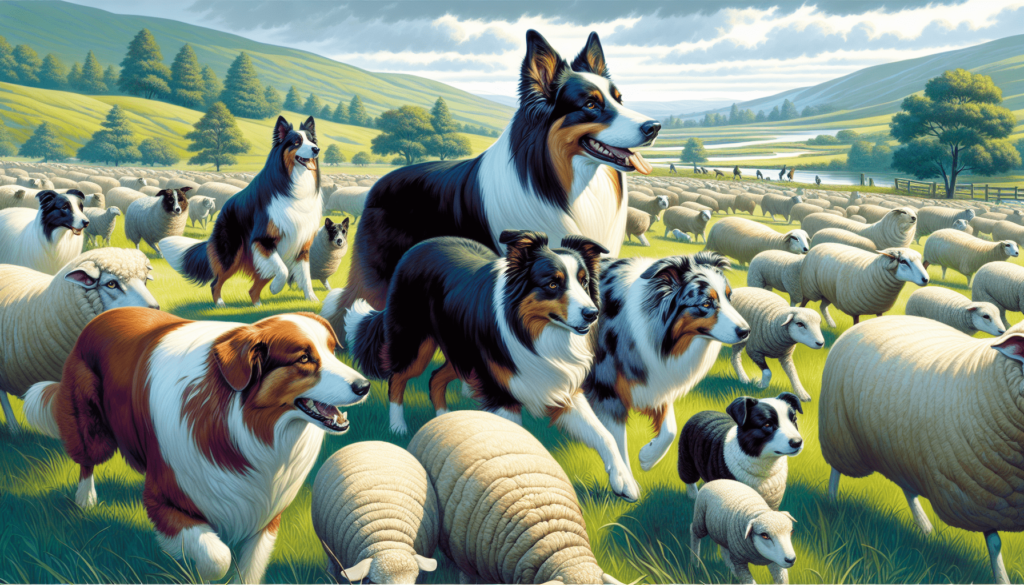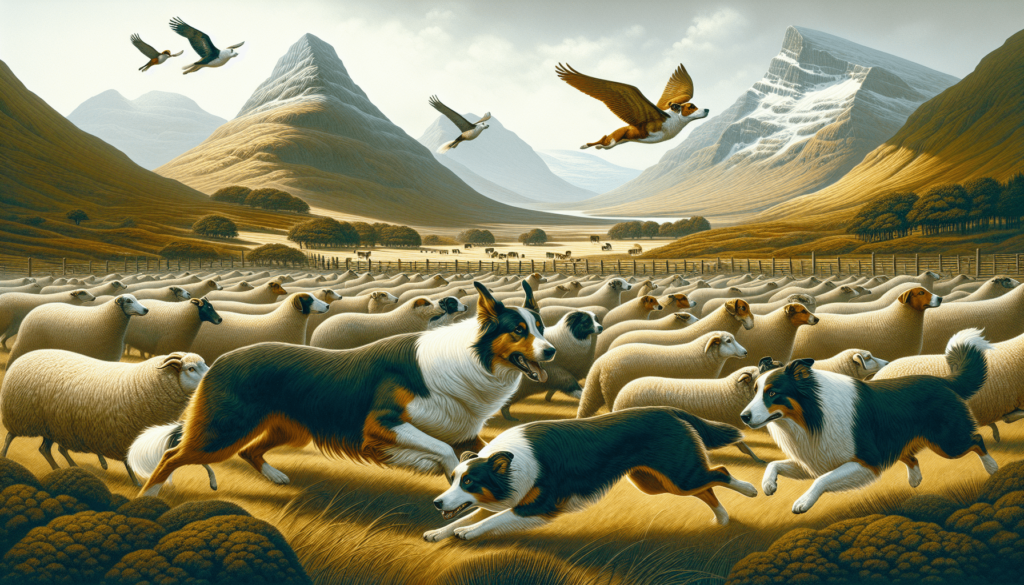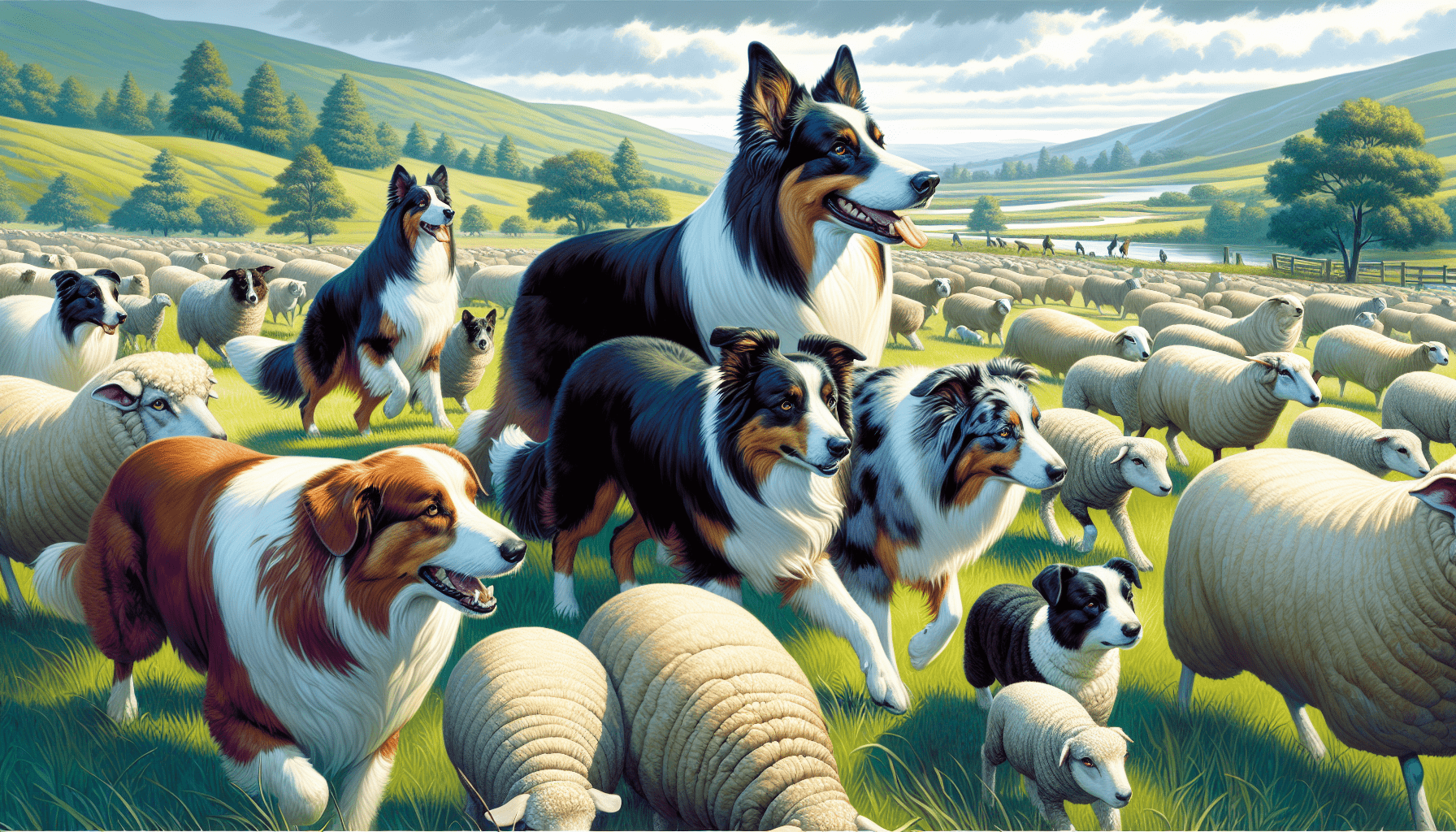Imagine yourself in a world where dogs are not just pets, but talented workers that help farmers round up livestock and keep order on the ranch. Enter the fascinating world of herding dog breeds, where intelligence, agility, and an innate herding instinct are the hallmarks of these remarkable canines. From the beloved Border Collie to the energetic Australian Cattle Dog, this article will take you on a journey through the captivating realm of herding dogs, showcasing their unique abilities and the special bond they form with their human counterparts. Get ready to be amazed by the astonishing skills of these incredible four-legged companions!

Herding Dog Breeds at a Glance
Border Collie
The Border Collie is known for its exceptional intelligence and herding abilities. They are highly trainable and excel in various dog sports such as obedience and agility. Border Collies have a medium-sized body with a double coat that comes in a variety of colors, including black and white, red and white, and tricolor. They are energetic dogs that require ample physical and mental exercise. With their friendly and affectionate nature, Border Collies make great family pets.
Australian Shepherd
The Australian Shepherd, often referred to as an “Aussie,” is a versatile and agile herding dog breed. Despite their name, Australian Shepherds were actually developed in the United States. They have a medium to large size and a thick double coat that comes in various colors and patterns. Australian Shepherds are known for their loyalty and protective nature, making them excellent family companions. They are highly intelligent and thrive in active households where they can participate in outdoor activities.
German Shepherd
The German Shepherd is a well-known breed that has excelled in various roles, including herding, search and rescue, and police work. They are highly intelligent, versatile, and trainable. German Shepherds have a medium to large size with a dense double coat that comes in a range of colors, most commonly black and tan. Their confident and fearless nature, along with their protective instincts, make them excellent working dogs and loyal companions. German Shepherds require regular exercise and mental stimulation to be happy and well-adjusted.
Pembroke Welsh Corgi
The Pembroke Welsh Corgi is a small herding breed that originated in Wales. Despite their short stature, they are agile and capable herders. Corgis have a sturdy body with a fluffy double coat that is usually red, sable, or tricolor. They are known for their delightful personalities, loyalty, and intelligence. Corgis make wonderful family pets and are particularly good with children. However, they do have high energy levels and require regular exercise and mental stimulation to prevent behavioral issues.
Shetland Sheepdog
The Shetland Sheepdog, often called a “Sheltie,” is a small herding dog breed that hails from the Shetland Islands in Scotland. They have a medium-sized body with a long, thick double coat that comes in various colors, including sable, black, and blue merle. Shelties are known for their intelligence, agility, and loyalty. They are excellent family dogs and get along well with children and other pets. Shelties excel in obedience and agility trials and are highly trainable.
History of Herding Dog Breeds
Origins of Herding Dogs
Herding dogs have a long history that dates back thousands of years. They were originally bred to assist humans in managing and moving livestock. The exact origins of herding dogs are difficult to trace, but it is believed that they evolved from domesticated wolves who showed natural herding instincts. Different herding dog breeds have developed in various regions around the world, adapting to the specific needs and terrain of their respective environments.
Domestication of Herding Dogs
As humans transitioned from hunter-gatherers to agricultural communities, the need for herding dogs became essential. These dogs played a crucial role in helping humans control and protect their livestock. Over time, humans selectively bred dogs with desirable herding traits, such as intelligence, agility, and the ability to work independently. This selective breeding process led to the development of specific herding dog breeds that excelled in their designated roles.
Role of Herding Dogs in Society
Herding dogs have played a vital role in agricultural societies throughout history. They have assisted in the herding and management of various livestock, including sheep, cattle, and geese. Their innate herding instincts and ability to respond to human commands have made them indispensable working companions. In addition to their herding duties, herding dogs have also been utilized in search and rescue missions, as well as in police and military work.
Characteristics of Herding Dog Breeds
Intelligence and Trainability
One of the defining characteristics of herding dogs is their exceptional intelligence. They are quick to learn and can easily understand and execute complex commands. This intelligence, combined with their natural herding instincts, makes them highly trainable dogs. Herding breeds thrive on mental stimulation and enjoy learning new tasks and skills. Their ability to problem solve and think independently enables them to excel in various working roles.
Physical Appearance
Herding dog breeds come in a variety of sizes, ranging from small to large. Each breed has its own distinct physical appearance, but they generally share common characteristics such as a sturdy body, erect or semi-erect ears, and a double coat that provides protection from harsh weather conditions. The colors and patterns of their coats can vary widely, from solid colors to merle or bi-color patterns, depending on the breed.
Energy Levels
Herding dogs are known for their high energy levels. This is due to their original purpose of actively moving and managing livestock. These breeds require regular and vigorous exercise to fulfill their physical and mental needs. Daily walks, playtime, and engaging activities help to channel their energy constructively. Without adequate exercise, herding dogs may become bored and exhibit destructive behavior.
Temperament
The temperament of herding dog breeds can vary, but they generally exhibit loyal, protective, and alert characteristics. They are dedicated and form strong bonds with their families. Herding dogs are often reserved with strangers but are generally friendly and affectionate with their loved ones. Proper socialization from a young age is crucial to ensure that they are well-adjusted and comfortable in various social situations.
Working Drive
Herding dogs have an innate drive to work. This working drive is deeply ingrained in their instincts and is what makes them excel in herding tasks. They are hardworking and diligent, always ready to take on the next challenge. This strong working drive can be channeled into various activities, such as dog sports, obedience training, or even specific working roles like search and rescue.
Herding Instincts and Working Abilities
Natural Herding Instincts
Herding dog breeds display natural herding instincts that have been honed through selective breeding over centuries. These instincts include gathering, driving, and controlling the movement of livestock. Herding dogs have an innate understanding of how to position themselves in relation to the livestock and use both eye contact and physical cues to guide and direct them.
Different Herding Styles
There are different herding styles exhibited by various herding dog breeds. Some breeds, like Border Collies, have a strong eye and prefer to work in close proximity to the livestock, using their intense gaze to control and move them. Others, like Australian Shepherds, have a more upright or loose-eyed herding style, where they rely on their physical presence and movement to guide the livestock. Each herding style has its own advantages and is suited for different types of livestock and terrain.
Herding Trials and Competitions
Herding trials and competitions provide an opportunity to showcase the skills and working abilities of herding dogs. These events simulate real-life herding situations, requiring dogs to demonstrate their aptitude for gathering, driving, and penning livestock. Trials are judged based on the dog’s ability to listen and respond to commands, as well as their effectiveness in controlling the livestock. These competitions not only celebrate the herding instincts of these breeds but also help to preserve and promote their working heritage.

Popular Herding Dogs in Different Countries
United States
In the United States, Border Collies and Australian Shepherds are two of the most popular herding dog breeds. Their intelligence, versatility, and working abilities have made them highly sought after for various purposes, including herding, dog sports, and as family companions. German Shepherds also have a significant presence in the United States, excelling in a wide range of roles, including herding, search and rescue, and law enforcement.
United Kingdom
The United Kingdom has a rich history of herding dog breeds, and the Border Collie is often considered the epitome of a British herding dog. Border Collies have been valued for their precision, work ethic, and adaptability in herding a variety of livestock. Traditional Welsh breeds like the Pembroke Welsh Corgi and the Shetland Sheepdog also have a strong following in the UK, thanks to their agility and herding skills in different terrains.
Australia
The Australian Shepherd, despite its name, was developed in the United States. However, it has gained significant popularity in Australia due to its versatility and adaptability in working with livestock in large, open areas. Australian Shepherds are valued for their endurance, intelligence, and ability to handle Australian livestock such as sheep and cattle.
Germany
Germany has a long history of using herding dogs, and the German Shepherd is an iconic breed closely associated with the country. German Shepherds, with their impeccable working abilities, are highly regarded and extensively utilized in various working roles, including herding, search and rescue, and law enforcement. Their loyal and protective nature, combined with their intelligence and versatility, has made them a favorite choice for many German dog enthusiasts.
Training and Socialization of Herding Dogs
Basic Training Commands
Training herding dogs begins with teaching them basic commands such as sit, stay, lie down, and come. These commands provide the foundation for more advanced training later on. Positive reinforcement techniques, such as using treats and verbal praise, work well with herding breeds as they respond enthusiastically to rewards. Consistency and patience are key when training these intelligent dogs, as they quickly pick up on cues and are eager to please.
Task-Specific Training
In addition to basic commands, herding dogs can be trained for specific tasks related to herding. This includes teaching them to respond to directional signals, such as left, right, and walk up, to guide the livestock effectively. They can also be trained to work with specific types of livestock, adapting their herding techniques accordingly. Advanced training in herding trials and competitions further hones their natural instincts and working abilities.
Socialization with Humans and Other Animals
Proper socialization is essential for herding dogs to ensure that they are well-adjusted and comfortable in different environments. Early socialization exposes them to various people, animals, and situations, helping them develop into confident and well-behaved individuals. Herding dogs should be introduced to different livestock species to familiarize them with their behaviors and movement patterns. Additionally, positive interactions with other dogs and animals promote friendly and non-aggressive behaviors in these breeds.
Health and Care of Herding Dog Breeds
Common Health Issues
Like all dog breeds, herding dog breeds are prone to certain health issues. Some common health concerns include hip dysplasia, progressive retinal atrophy, epilepsy, and certain autoimmune disorders. Regular veterinary check-ups, a nutritious diet, and regular exercise can help prevent or manage these conditions. It is crucial to obtain a puppy from a reputable breeder who conducts health screenings on their breeding stock to reduce the risk of inherited health problems.
Nutritional Needs
Herding dogs have higher energy requirements due to their active lifestyles. A balanced and high-quality diet that meets their specific nutritional needs is essential for their overall health and well-being. This includes providing a proper ratio of proteins, fats, and carbohydrates to support their energy levels and maintain their muscle mass. Consultation with a veterinarian can help determine the best diet plan for individual herding dog breeds.
Exercise Requirements
Herding dogs thrive on regular exercise and mental stimulation. Adequate exercise not only helps them expend their energy but also keeps them mentally engaged, preventing boredom and destructive behaviors. Daily walks, playtime, and engaging activities, such as fetch or puzzle games, are essential to meet their exercise needs. Herding breeds also benefit from participating in dog sports like obedience or agility, which provide them with the physical and mental stimulation they crave.
Grooming and Maintenance
Herding dog breeds generally have a dense double coat that requires regular grooming to keep it in good condition. This includes brushing to remove loose hair and prevent matting, as well as regular nail trims and dental care. The frequency of grooming varies depending on the length and thickness of the coat. In addition to regular grooming, these breeds may also benefit from routine ear cleaning and regular dental check-ups to maintain their overall health.
Herding Dogs as Working Animals
Livestock Guardian Dogs
While herding dogs are known for their ability to actively move and control livestock, there are also specific breeds known as livestock guardian dogs. These dogs are tasked with protecting livestock from predators rather than herding them. Breeds such as the Great Pyrenees and the Anatolian Shepherd Dog are commonly used as livestock guardians due to their size, strength, and protective instincts.
Search and Rescue Dogs
Herding dogs’ intelligence, agility, and endurance make them well-suited for search and rescue work. These dogs undergo specialized training to locate missing persons, whether in wilderness areas or urban settings. Their excellent scent detection and tracking abilities, combined with their determination and strong work ethic, make them indispensable in search and rescue operations.
Service and Therapy Dogs
The intelligence and trainability of herding dogs also make them highly suitable for service dog roles. They can be trained to assist individuals with disabilities, providing support with tasks such as opening doors, retrieving items, or even alerting their owners to medical emergencies. Additionally, the calm and gentle nature of these breeds makes them well-suited for therapy work, offering comfort and companionship to individuals in hospitals, nursing homes, or other therapeutic environments.
Herding Dogs in Popular Culture
Movies and TV Shows featuring Herding Dogs
Herding dog breeds have made their mark in the world of movies and television. From classic films like “Lassie” featuring a Rough Collie, to more recent movies like “Babe” where a Border Collie plays a prominent role, these films have showcased the intelligence and loyalty of herding dogs. TV shows like “The Littlest Hobo” and “Paw Patrol” also feature herding breeds, captivating audiences with their working abilities and lovable personalities.
Storybooks and Children’s Literature
Herding dog breeds have been featured in numerous children’s books, becoming beloved characters in stories that celebrate their intelligence, bravery, and loyalty. From “The Poky Little Puppy” featuring a Corgi to “Sheepdog in the Snow” portraying a Shetland Sheepdog, these books introduce children to the fascinating world of herding dogs and the valuable roles they play.
Herding Dogs in Art and Photography
The beauty and grace of herding dogs have inspired artists and photographers throughout history. Paintings, sculptures, and photographs capture their energetic spirit and working abilities. These artistic representations not only celebrate the physical beauty of these breeds but also pay tribute to their historical and cultural significance as vital members of agricultural communities.
Choosing the Right Herding Dog for You
Lifestyle and Activity Level
When considering a herding dog breed, it is important to assess your lifestyle and activity level. Herding dogs thrive in active households that can provide them with plenty of exercise and mental stimulation. If you lead a sedentary lifestyle or have limited time for daily exercise, a herding breed may not be the best fit for you.
Living Arrangements
The living arrangements should also be taken into account when choosing a herding dog. Many herding breeds require a considerable amount of space and may not be suitable for apartment living. Access to a secure yard or regular access to open spaces is ideal for these energetic dogs. Additionally, some herding breeds may be prone to excessive barking, which should be taken into consideration if you live in close quarters with neighbors.
Training Commitment
Herding dogs thrive on mental stimulation and require consistent and ongoing training. If you are not willing or able to invest time and effort into training and socialization, a herding breed may not be the best choice. These intelligent dogs can become bored and develop behavioral problems if not provided with proper guidance and mental stimulation.
Breed-Specific Considerations
Each herding dog breed has its own unique characteristics and requirements. Learning about the specific needs and traits of different herding breeds is important to ensure a good match. Consider factors such as grooming needs, potential health issues, and compatibility with children and other pets. Talking to experienced herding dog owners or breeders can provide valuable insights into the specific considerations of each breed.
In conclusion, the world of herding dog breeds is a fascinating and diverse one. From the intelligent and agile Border Collie to the versatile and loyal German Shepherd, each breed brings its own set of characteristics and working abilities. These dogs have a rich history of assisting humans in managing and wrangling livestock, and their innate instincts and trainability continue to make them valuable working companions. Whether as herding dogs, service animals, or beloved family pets, herding breeds leave an indelible mark on our lives and culture.

